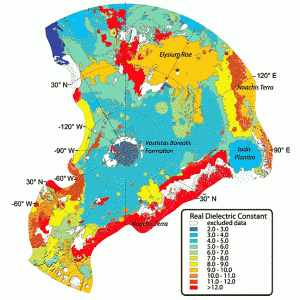The ground-penetrating radar instrument MARSIS on the Mars Express orbiter has measured the electrical properties of the north and south polar regions. The results, reported in Geophysical Research Letters by Jérémie Mouginot (University of California, Irvine) and colleagues, strongly support the idea that the Martian northern plains once held a large body of water.

POLAR OCEAN FLOOR? Cool colors map the location of surface materials with low dielectric constants, indicating where ancient ocean sediments may lie. Warm colors point to areas with high dielectric constants, such as the volcanic rocks of Elysium and the heavily cratered terrain in Noachis. Isidis is a small impact basin likely flooded by outflow channels or spillover from the northern ocean. (Image is Figure 2 from the paper.)
The hypothetical northern ocean — sometimes dubbed Oceanus Borealis — is not a new idea, and scientists have long argued both for and against it. Consensus identifies the Vastitas Borealis Formation, which occupies much of the northern lowlands, as a roughly 100-meter thick sedimentary veneer that overlies volcanic ridged plains. It lies within the proposed shorelines for the ancient ocean. (In 2008, NASA’s Phoenix lander set down on one part of the formation and found water ice just a few inches below the dry surface soil.)
“As such,” say the researchers, “the formation represents the best geologic evidence to date for the existence of an ocean in the Late Hesperian, about 3 billion years ago.”
The MARSIS radar mapped the dielectric constant of the surface materials down to a depth of roughly 100 meters (yards). As measured by the radar, dense volcanic rock would have a dielectric constant of around 10 and pure ice would have a value of 3.1. The Vastitas Borealis Formation shows values of 4 to 5. At the same time, volcanic flows in Elysium have values of around 9 and the cratered highlands of Noachis Terra show values of 10 and higher.
“Although much is still unknown about the evolution and environmental context of a Late Hesperian ocean,” the team writes, “our observations provide persuasive evidence of its existence by the measurement of a dielectric constant of the Vastitas Borealis Formation that is sufficiently low that it can only be explained by the widespread deposition of (now desiccated) aqueous sediments or sediments mixed with massive ice.”
Where did the ocean go? The researchers point to two possible fates. “The water that once filled the Late Hesperian ocean may have either sublimed into the atmosphere (and become cold-trapped elsewhere on the planet), or it froze in place and is preserved underground.”









Pingback: Oceanus Borealis: Mars Express trova nuove evidenze per un antico oceano su Marte « TuttiDentro
Pingback: - The Meridiani Journal
Pingback: ‘Oceanus Borealis’ – Mars Express Finds New Evidence for Ancient Ocean on Mars | My Blog